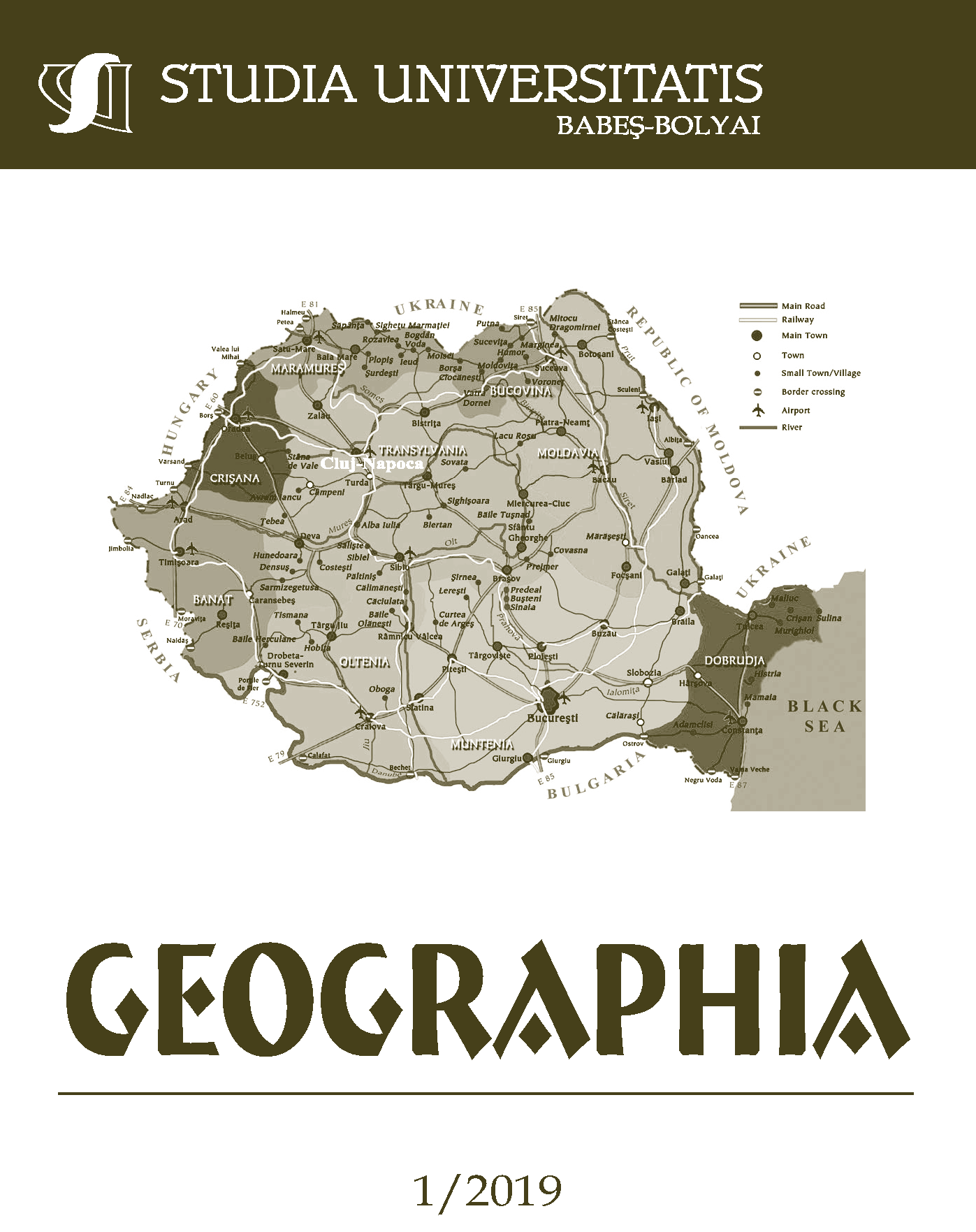RESHAPING WATERS. A HISTORY OF POLITICAL INTERFERENCE IN THE RISE AND FALL OF THE ROMANIAN SPA-TOWNS – CASE STUDY: SÂNGEORZ-BĂI
DOI:
https://doi.org/10.24193/subbgeogr.2019.1.04Keywords:
spa-town; heritage; mineral waters; villa; balneotherapy, sojourn; tourism.Abstract
A curious case in Romania’s architectural narrative is represented by its spa-towns, many of which have had seemingly regrettable fates. Once the crown jewels of the country’s tourism segment, only a few of this type of urban developments have retained their prestige, many of them being mere shadows of what they once were. Sângeorz-Băi, a small town in the northern county of Bistrița-Năsăud, falls somewhere in-between these two categories. By definition, spa-towns are resort towns developed on mineral springs that have appeared naturally and have been preserved for their health benefits. Seeing as the spa-town archetype is based on a commodity meant to be enjoyed by people, the interference of politics in the evolution of this type of urban entities came naturally. The proposed article means to explore how political interference affected the evolution of the aforementioned towns, Sângeorz-Băi being used as a case study that mirrors the ways in which political actors have affected the whole array of Romanian spa-towns. The entire intended discourse’s foundation would be based on reviewing the perks and misadventures that this type of towns have encountered through their existence, aspects that will be documented through archive studies, historical research and personal experience – the author of the intended article being a native of the spa-town Sângeorz-Băi, and also, in a way, a political actor himself, struggling to preserve some of the last historical buildings that the local authorities have yet to demolish (Fig.1).References
„Acord între Societatea Hebe și ‘Generala’ S.A. de Comerț și Industrie pentru a exporta apă în Anglia și S.U.A.” [“Agreement between the Hebe Society and ‘Generala’ S.A. regarding mineral water exportation to England and the U.S.”] (1926), Arhivele Naționale, Serviciul Județean Bistrița-Năsăud, f. 00143, „Societatea Hebe 1882-1939”.
„Administrația Fondurilor Grănicerești Năsăudene” [“The administration of the Frontier Regiment Funds”] (1860-1895), Arhivele Naționale, Serviciul Județean Bistrița-Năsăud, f.2757, ff. 1-114.
Alexi, A.P. (1892), “Die St.-Georger Säuerlinge im Nordosten Siebenbürgens und die Flora auf dem Gebiete derselben”, Druck Von Josef Drotleff, Hermannstadt, pp. 1-11.
„Asistența socială balneară” [“Spa social assitance”] (1929), in Curierul Băilor, Stațiunilor Climatice și turismului, Societatea de Hidrologie și Climatologie medicale, nr. 15, 30 October 1929, București, p.172.
„Aviz de lichidare a Societății ‘Hebe’” [“Liquidation notice regarding the ‘Hebe’ Society”] (1928), Arhivele Naționale, Serviciul Județean Bistrița-Năsăud, f. 00143, „Societatea Hebe 1882-1939”.
„Băi minerale climatice în Sîngeorzul-Român (Oláhszentgyörgy)” [“Climatic mineral baths in Sîngeorzul-Român”] (n.d.), Tipografia G. Matheiu, Bistrița.
„Contract de arendare între comună și Societatea Hebe” [“Lease Contract between the Society and the Town”] (1922), Arhivele Naționale, Serviciul Județean Bistrița-Năsăud, f. 00143, “Societatea Hebe 1882-1939”, pp.1-8.
Cotuțiu, Liviu (2005), „Cine este acționar majoritar la Hebe S.A.?”, Gazeta de Bistrița, Bistrița, 20 iunie 2005, https://www.hotnews.ro/stiri-presa_regionala_arhiva-1734891-cine-este-actionar-majoritar-hebe.htm – last accessed on March 1, 2019, 18:00.
„Foc mare la Sângeorz-Băi” [“Big fire in Sângeorz-Băi”] (1939), în Unirea Poporului, Blaj, nr. 35, 27 August 1939, p.2.
Gheorghe, Eugen (2016), „Ce se va întâmpla cu Vila nr. 1 din Sîngeorz-Băi, monument istoric”, Timp Online, Bistrița, 23 decembrie 2016, https://timponline.ro/ce-se-va-intampla-cu-vila-nr-1-din-singeorz-bai-monument-istoric/ - last accessed on March 1, 2019, 18:00.
Hajdu, Ada (2012), „Arhitectura de Vilegiatură în România Modernă”, teză de doctorat, Universitatea Națională de Arte, București, pp.14-50.
„Invitare Serata Teatrală-Muzicală” [“Invitation for a Theatrical and Musical Evening Event”], (1914), Arhivele Naționale, Serviciul Județean Bistrița-Năsăud, f. 00143, “Societatea Hebe 1882-1939”, (Tip. G. Matheiu, Bistrița).
„Încă o faptă rea comunală” [“Another communal bad deed”] (1929), în Curierul Băilor, Stațiunilor Climatice și turismului, Societatea de Hidrologie și Climatologie medicale, nr. 15, 30 Octombrie 1929, București, p.179.
Legea nr. 569 din 26 Martie 1936 [The No. 569 Law from the 26th of March 1936] (1936), Art. 111-114.
MacCannell, Dean (1999), “The Tourist: A New Theory of the Leisure Class”, University of California Press, Berkeley, pp.1-42.
„Prospect al Băilor Alcalino-Muratice ‘Hebe’ din Sângeorgiul-Român, Comitatu Bistrița-Năsăud (Transilvania)” [“Prospect of the ‘Hebe’ Alkaline Baths from Sângeorgiul-Român, Bistrița-Năsăud County, (Transylvania)”] (1904), Tipografia G.Matheiu, Bistrița.
„Protecțiunea apelor minerale în Franța” [“Mineral water protection in France”] (1929), în Curierul Băilor, Stațiunilor Climatice și turismului, Societatea de Hidrologie și Climatologie medicale, nr. 15, 30 Octombrie 1929, București, p.174.
Racoviță, Emil (1929), „Oficiul Național Turistic – Necesitatea Organizărei lui în România” [“The National Touristic Office and the Need for its Creation in Romania”], în Curierul Băilor, Stațiunilor Climatice și turismului, Societatea de Hidrologie și Climatologie medicale, nr. 15, 30 Octombrie 1929, București, pp.173-174.
Ruskin, John (1849), “The seven lamps of Architecture”, John Wiley, 161 Broadway, New York, p.9.
Sohorca, Iustin (1986), „Povestea Comunei Sîngeorz-Băi”, Cercul Plaiuri Năsăudene și Bistrițene, Cluj-Napoca, pp.17-53.
„Tabloul vizitatorilor Băilor ‘Hebe’ din Sîngeorz-Băi” [Visitors Tableau of the ‘Hebe’ Baths of Sîngeorz-Băi] (1927), Arhivele Naționale, Serviciul Județean Bistrița-Năsăud, f. 00143, “Societatea Hebe 1882-1939”.
Voinea, Alexandra; Baran, Dana (2008), „O incursiune în istoria întreținerii sănătății prin apă în România”, Jurnal Medical Brașovean, Brașov, pp.172-176.
Vlașin, Cornelia-Nicoleta (2014), „Istoricul Fondurilor Grănicerești 1851-1947”, PhD diss., Institutul de Istorie „George Barițiu” al Academiei Române, Cluj-Napoca, pp.6-7.
Vlădică, Mircea (2003), „Sîngeorz-Băi, Veche Vatră de Credință și Cultură Românească”, Editura Napoca Star, Cluj, p.253.
Downloads
Published
How to Cite
Issue
Section
License
Copyright (c) 2019 Studia Universitatis Babeș-Bolyai Geographia

This work is licensed under a Creative Commons Attribution-NonCommercial-NoDerivatives 4.0 International License.





 ©Studia Universitatis Babeş-Bolyai Geographia. Published by Babeș-Bolyai University.
©Studia Universitatis Babeş-Bolyai Geographia. Published by Babeș-Bolyai University.